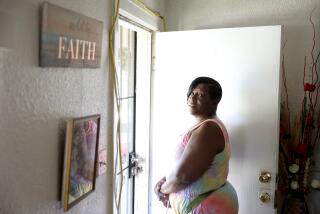Orphanages May Await Abused Children : Social welfare: With the foster care system overburdened, Illinois governor explores alternatives.
- Share via
CHICAGO — By the time Tyrese Davis was 9, his alcoholic father was dead and his mother gone.
Davis, now 18, spent the last nine years in an orphanage. “It’s like a real family,” he said. “They care. They want to see us do well.”
Orphanages like Maryville City of Youth in suburban Chicago, where Davis lives, are getting more attention years after falling into disfavor.
In the last six months, the state of Illinois has taken custody of more than 4,000 children. The Department of Children and Family Services now cares for 37,500 children, up from 8,000 in 1986.
The foster care system can’t care for all the abused and neglected children. Earlier this month, Gov. Jim Edgar said he is thinking about sending some to orphanages.
Critics pounced. Others praised the idea. Most agreed today’s orphanages are a far cry from the stark, cruel institutions Charles Dickens portrayed in “Oliver Twist.”
“I don’t think the governor or anybody else wants to go back to the days when we warehoused children,” said Jerry Slomka, a state social services administrator and chairman of a task force on housing neglected children.
But Mark Testa, a professor at the University of Chicago’s School of Social Service Administration, said the state could end up creating a class of “social orphans.”
Orphanages “create a set of behaviors that were adaptive to the institution and not very well adaptive outside the institution,” Testa said.
Orphanages spread across the United States in the late 1800s, many founded to house the children of immigrants fallen on hard times. They were often crowded, unsanitary and staggered by epidemics. By the 1930s, they began disappearing and have been replaced by foster parents who take one or more children into their own homes.
But social workers have been criticized recently for not being more aggressive in putting neglected or abused children into the overburdened foster care system.
In April, a woman was charged with hanging her 3-year-old son. The agency had returned the boy to her three times despite her history of mental illness.
On Thanksgiving, a woman took her bruised 5-year-old, who weighed 18 pounds, to a hospital. Caseworkers had visited the home but did not remove the boy.
Earlier this month, 19 children were found in a filthy apartment, some sharing a bone with a dog. Caseworkers had knocked on the door on three occasions since August, but left each time without demanding to enter.
Few support orphanages as strongly as Judge William Maddux, who spent five years at Father Flanagan’s Home for Boys in Boys Town, Neb. Maddux is a supervisor in Cook County Juvenile Court.
“You can get some bad foster parents, and generally you don’t find out about it until it’s too late,” he said.
“Most folks who will give you this sentimentality about the family is the best place to be never came from a bad family,” said Maddux, who left a dirt-floor shanty for Boys Town. “I thought Boys Town was the best place you could ever be.”
Money is another consideration.
Each child in foster care costs the state about $350 a month, while the average cost in a residential treatment facility is about $4,200 a month, Slomka said.
But supporters point to places like Maryville, where about 800 children live in groups of 10. The children help their house-parents with cooking, shopping and other chores.
Davis is preparing to join Maryville’s independent-living program; he will seek an apartment and job off campus.
“It’s not the same as having a family--as having a mommy and daddy,” he said, but “I’m happy with Maryville.”
More to Read
Sign up for Essential California
The most important California stories and recommendations in your inbox every morning.
You may occasionally receive promotional content from the Los Angeles Times.












